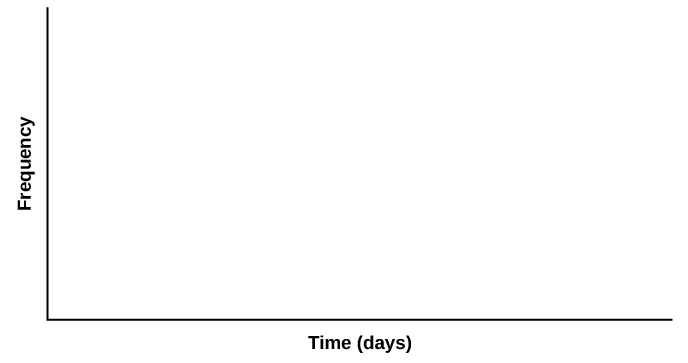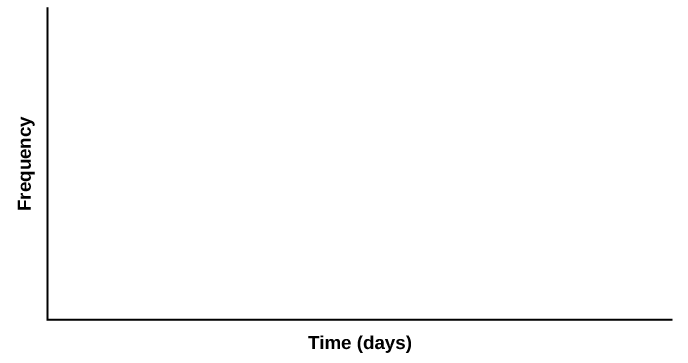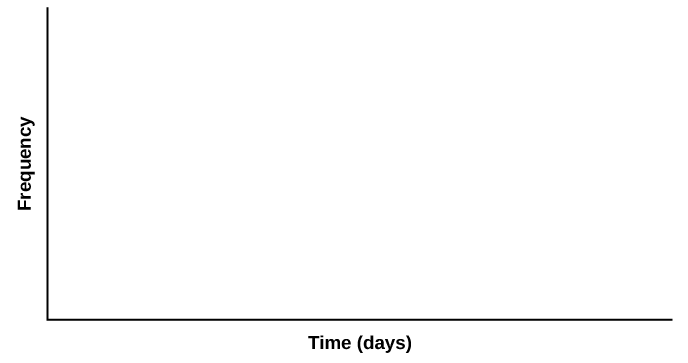The Central Limit Theorem
Central Limit Theorem (Cookie Recipes)
OpenStaxCollege
[latexpage]
Class Time:
Names:
- The student will demonstrate and compare properties of the central limit theorem.
GivenX = length of time (in days) that a cookie recipe lasted at the Olmstead Homestead. (Assume that each of the different recipes makes the same quantity of cookies.)
| Recipe # | X | Recipe # | X | Recipe # | X | Recipe # | X | |||
|---|---|---|---|---|---|---|---|---|---|---|
| 1 | 1 | 16 | 2 | 31 | 3 | 46 | 2 | |||
| 2 | 5 | 17 | 2 | 32 | 4 | 47 | 2 | |||
| 3 | 2 | 18 | 4 | 33 | 5 | 48 | 11 | |||
| 4 | 5 | 19 | 6 | 34 | 6 | 49 | 5 | |||
| 5 | 6 | 20 | 1 | 35 | 6 | 50 | 5 | |||
| 6 | 1 | 21 | 6 | 36 | 1 | 51 | 4 | |||
| 7 | 2 | 22 | 5 | 37 | 1 | 52 | 6 | |||
| 8 | 6 | 23 | 2 | 38 | 2 | 53 | 5 | |||
| 9 | 5 | 24 | 5 | 39 | 1 | 54 | 1 | |||
| 10 | 2 | 25 | 1 | 40 | 6 | 55 | 1 | |||
| 11 | 5 | 26 | 6 | 41 | 1 | 56 | 2 | |||
| 12 | 1 | 27 | 4 | 42 | 6 | 57 | 4 | |||
| 13 | 1 | 28 | 1 | 43 | 2 | 58 | 3 | |||
| 14 | 3 | 29 | 6 | 44 | 6 | 59 | 6 | |||
| 15 | 2 | 30 | 2 | 45 | 2 | 60 | 5 |
Calculate the following:
Collect the DataUse a random number generator to randomly select four samples of size n = 5 from the given population. Record your samples in [link]. Then, for each sample, calculate the mean to the nearest tenth. Record them in the spaces provided. Record the sample means for the rest of the class.
- Complete the table:
Sample 1 Sample 2 Sample 3 Sample 4 Sample means from other groups: Means: \(\overline{x}\) = ____ \(\overline{x}\) = ____ \(\overline{x}\) = ____ \(\overline{x}\) = ____ - Calculate the following:
- \(\overline{x}\) = _______
- s\(\overline{x}\) = _______
- Again, use a random number generator to randomly select four samples from the population. This time, make the samples of size n = 10. Record the samples in [link]. As before, for each sample, calculate the mean to the nearest tenth. Record them in the spaces provided. Record the sample means for the rest of the class.
Sample 1 Sample 2 Sample 3 Sample 4 Sample means from other groups Means: \(\overline{x}\) = ____ \(\overline{x}\) = ____ \(\overline{x}\) = ____ \(\overline{x}\) = ____ - Calculate the following:
- \(\overline{x}\) = ______
- s\(\overline{x}\) = ______
- For the original population, construct a histogram. Make intervals with a bar width of one day. Sketch the graph using a ruler and pencil. Scale the axes.

- Draw a smooth curve through the tops of the bars of the histogram. Use one to two complete sentences to describe the general shape of the curve.
- For the sample of n = 5 days averaged together, construct a histogram of the averages (your means together with the means of the other groups). Make intervals with bar widths of \(\frac{1}{2}\) a day. Sketch the graph using a ruler and pencil. Scale the axes.

- Draw a smooth curve through the tops of the bars of the histogram. Use one to two complete sentences to describe the general shape of the curve.
- For the sample of n = 10 days averaged together, construct a histogram of the averages (your means together with the means of the other groups). Make intervals with bar widths of \(\frac{1}{2}\) a day. Sketch the graph using a ruler and pencil. Scale the axes.

- Draw a smooth curve through the tops of the bars of the histogram. Use one to two complete sentences to describe the general shape of the curve.
- Compare the three histograms you have made, the one for the population and the two for the sample means. In three to five sentences, describe the similarities and differences.
- State the theoretical (according to the clt) distributions for the sample means.
- n = 5: \(\overline{x}\) ~ _____(_____,_____)
- n = 10: \(\overline{x}\) ~ _____(_____,_____)
- Are the sample means for n = 5 and n = 10 “close” to the theoretical mean, μx? Explain why or why not.
- Which of the two distributions of sample means has the smaller standard deviation? Why?
- As n changed, why did the shape of the distribution of the data change? Use one to two complete sentences to explain what happened.



